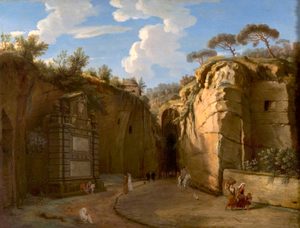The Grotto of Pozzuoli, with Virgil's Tomb
Artist: Gaspar van Wittel (known as Gaspare Vanvitelli)
On display
This view shows the Grotta di Pozzuoli. Still visible today in the bay of Naples, it was a sight that fascinated artists and Grand Tourists during the eighteenth and nineteenth centuries. It was not a natural cavity, but a 700m long tunnel excavated through the soft volcanic rock by the Roman emperor Augustus (63BC–14AD) to provide a road link between Naples and Pozzuoli. The romantic appeal that the site held for artists, especially foreign artists, between the eighteenth and nineteenth century, was increased by the discovery of an ancient columbarium covered over with tangled vegetation that a long tradition identified as the burial place of the Latin poet Virgil. In this painting Virgil’s tomb – a simple rectangular structure surmounted by a small dome – can be seen in the upper left, by the entrance to the grotto. The stone monument to the left foreground commemorates the work undertaken by Alfonso of Aragon (1481-1500) in the fifteenth century when the tunnel was paved, and its entrance enlarged. The dark and narrow southern entrance to the Grotto rises at the heart of the composition.
The Dutch artist Gaspar Van Wittel, Italianised as Gaspare Vanvitelli, arrived in Naples in 1699 at the invitation of the Duke of Medinaceli (1660–1711), Viceroy of Naples, who soon became his patron. Van Wittel stayed in Naples for two and a half years, during which time he painted 35 topographical scenes. Among them was a large oil painting of the Grotto of Posillipo, signed and dated 1701. This view of the grotto is dated one year later, in 1702. In total, the artist painted 14 different autograph versions of the grotto between 1701 and 1715.
Van Wittel’s view paintings derive from his pursuit of a sincere, immediate, and deep understanding of the world he lived in. His views of cities, hills, rivers, and harbours are populated by an array of figures – some absorbed in silent contemplation, other busily going about their daily routine – that create a series of vivid, fragmentary narratives, all played out under a serene, unifying Mediterranean light. In this view, the foreground contains the seated figure of a man in a white mantle. This particular figure became a kind of recurring trademark for Van Wittel. A peasant’s family passes in front of him, having just walked through the tunnel and therefore coming from Pozzuoli and heading towards Mergellina. Other figures on horseback and on foot animate the scene, while some rest on the steps of the monument dedicated to Augustus. Among them, some Grand Tourists read the inscription on the marble slab. Their presence reminds us that this unique passage and the two monuments were among the most popular sights in the Kingdom of Naples.
Signed and Dated: GAS V W/ 1702.
Details
- Artist
- Gaspar van Wittel (known as Gaspare Vanvitelli)
- Title
- The Grotto of Pozzuoli, with Virgil's Tomb
- Date
- 1702
- Medium
- Oil on canvas
- Dimensions
- 49 x 64.2 cm (unframed); 67 x 85 cm (framed)
- Reference
- CVCSC:0206.S
- Collection
- Naples

